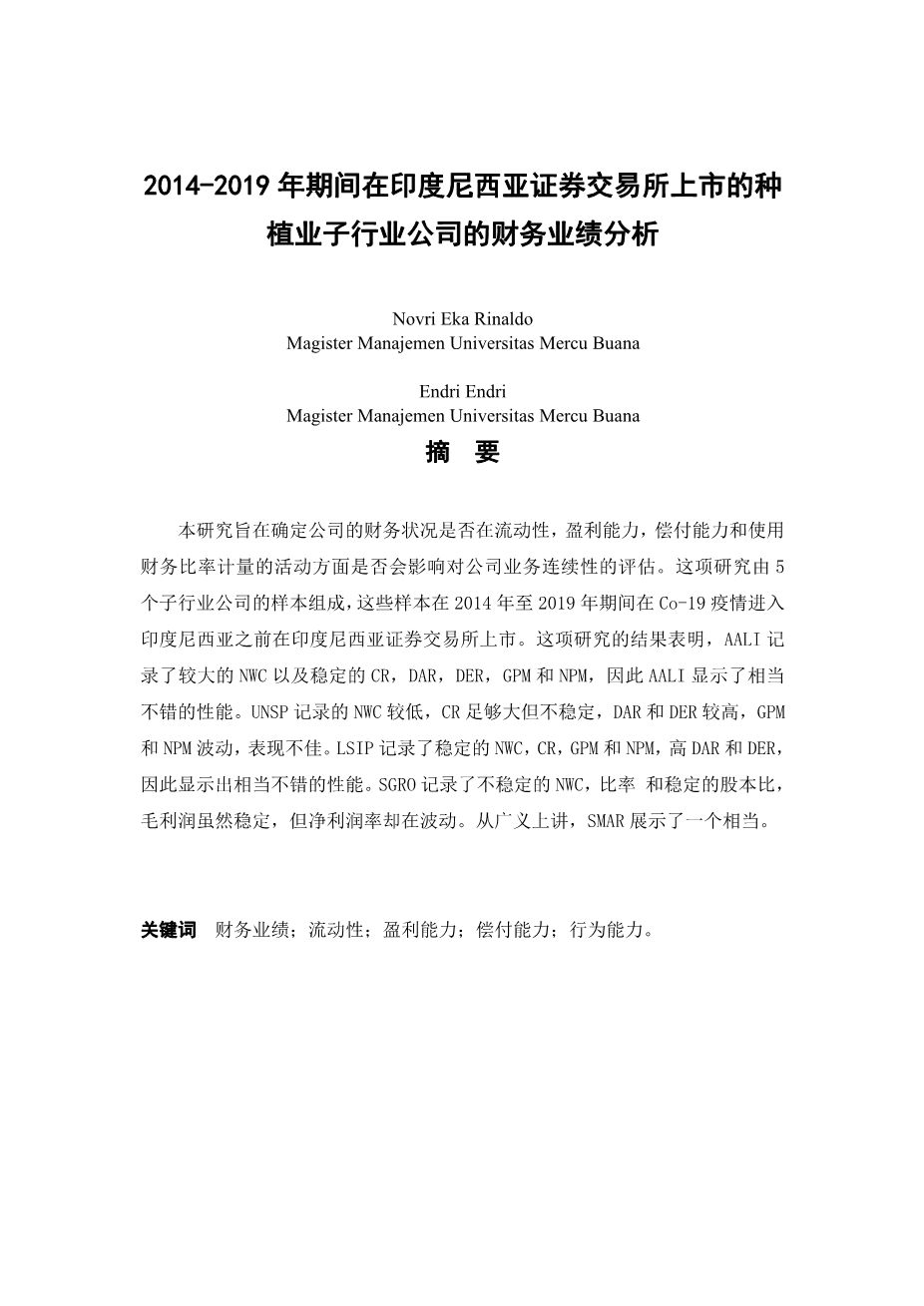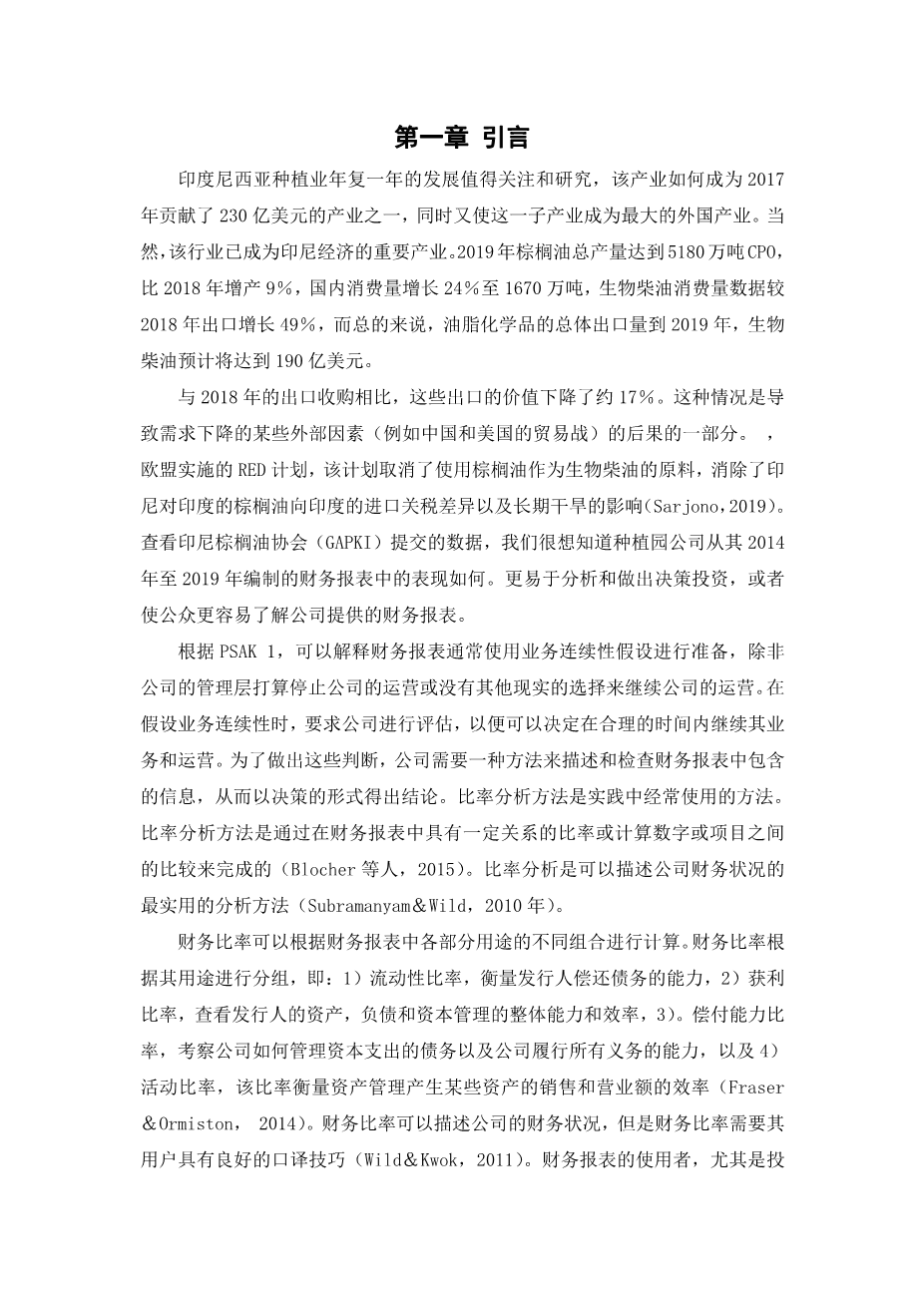ANALYSIS OF FINANCIAL PERFORMANCE OF PLANTATION SUB-SECTOR COMPANIES LISTED ON THE INDONESIA STOCK EXCHANGE FOR THE 2014-2019 PERIOD
Novri Eka Rinaldo
Magister Manajemen Universitas Mercu Buana
Endri Endri
Magister Manajemen Universitas Mercu Buana
Abstract
This study aims to determine whether the companys financial condition in terms of liquidity, profitability, solvency and activities measured using financial ratios tends to affect the assessment of the companys business continuity. This study consisted of 5 samples of sub-sectoral companies that were listed on the Indonesia stock exchange in the 2014-2019 period, before the co-19 outbreak entered Indonesia. The results of this study AALI recorded a large NWC and CR, DAR, DER, GPM, and NPM that were stable so that AALI showed quite good performance. UNSP recorded a low NWC, a CR large enough but unstable, a high DAR and DER and a fluctuating GPM and NPM that showed poor performance. LSIP recorded a stable NWC, CR, GPM and NPM, high DAR and DER so that it showed quite good performance. SGRO recorded an unstable NWC, stable CR, high DAR and DER, fluctuating GPM and NPM so that it showed poor performance SMAR recorded stable net working capital, stable current ratio, debt to asset ration and stable debt to equity ratio, gross profit which is stable but fluctuating net profit margin. Broadly speaking, SMAR shows a fairly.
Keywords: Financial Performance;Liquidity;Profitability; Solvency;Actitivites.
I. INTRODUCTION
The development of the plantation industry in Indonesia from year to year is interesting to look at and to examine financially, how is this industry one of the industries that in 2017 contributed USD 23 billion, and at the same time strengthened this subsector as the largest foreign exchange earner for Indonesia, of course this sector became a vital industry for the Indonesian economy. Total palm oil production in 2019 reached 51.8 million tons of CPO or 9% higher than production in 2018, domestic consumption increased 24% to 16.7 million tons with Biodiesel consumption data up 49% from 2018 exports, while in general the overall export of oleo chemicals and biodiesel in 2019 is predicted to reach USD 19 billion.
The value of these exports fell by around 17% when compared with the acquisition of exports in 2018. The condition is part of the consequences of some external factors that caused the decline in demand, such as the issue of trade war in China and the USA, RED implementation by the EU which eliminates the use of palm oil as material Biodiesel, differences in import tariffs on Indonesian palm oil to India, and the effects of prolonged drought (Sarjono, 2019). Looking at the data presented by the Indonesian Palm Oil Association (GAPKI), it makes us interested to see how far the performance of the plantation companies is seen from the financial statements they compiled from 2014 to 2019. We conducted this research aimed at making it easier to analyze and make decisions investment or for the general public about the financial statements presented by the company.
Based on PSAK 1, it is explained that financial statements are generally prepared using business continuity assumptions, except if the companys management intends to stop the companys operations or do not have other realistic alternatives to continue the companys operations. In assuming business continuity, the company is required to make an assessment so that it can be decided to continue its business and operations within a reasonable period of time. To make these judgments, companies need a method to describe and examine the information contained in the financial statements to make conclusions in the form of decisions. The ratio analysis method is a method often used in practice. Ratio analysis method is done by making ratios or calculating comparisons between numbers or items in financial statements that have a certain relationship (Blocher et al., 2015). Ratio analysis is the most practical method of analysis that can describe a companys financial condition (Subramanyam amp; Wild, 2010).
Financial ratios can be calculated from various combinations of subsections in the financial statements with different uses. Financial ratios are grouped based on their uses, namely: 1) Liquidity ratios, measuring the ability of issuers to pay their obligations, 2) profitability ratios, looking at the issuers overall capability and efficiency of asset, liability and capital management, 3). Solvency ratios, looking at how the company manages debt spent with capital, and the companys ability to fulfill all its obligations, and 4) activity ratios, which measure the efficiency of asset management to produce sales and turnover of certain assets (Fraser amp; Ormiston, 2014). Financial ratios can describe the financial condition of a company, but financial ratios require good interpretation skills from its users (Wild amp; Kwok, 2011). Users of financial statements, especially investors and creditors must pay attention to the continuity of the companys business to avoid the risk of losing investment or lending funds. Analysis of financial statements is an important way for investors, creditors, tax managers and regulators to understand the financial situation of a company. Limited studies of financial statement analysis can reveal the lack of financial statement analysis, approach the truth of a companys financial data as much as possible, make users remain rational and reasonable and correct judgment with careful financial analysis data (Endri et al., 2019)
In this case investors and creditors can rely on the auditors assessment of the companys business continuity. Investors and creditors expect the auditor to provide a warning (warning) of financial failure (financial failure) from the company. Previous research conducted
剩余内容已隐藏,支付完成后下载完整资料


英语译文共 13 页,剩余内容已隐藏,支付完成后下载完整资料
资料编号:[605366],资料为PDF文档或Word文档,PDF文档可免费转换为Word
您可能感兴趣的文章
- 饮用水微生物群:一个全面的时空研究,以监测巴黎供水系统的水质外文翻译资料
- 步进电机控制和摩擦模型对复杂机械系统精确定位的影响外文翻译资料
- 具有温湿度控制的开式阴极PEM燃料电池性能的提升外文翻译资料
- 警报定时系统对驾驶员行为的影响:调查驾驶员信任的差异以及根据警报定时对警报的响应外文翻译资料
- 门禁系统的零知识认证解决方案外文翻译资料
- 车辆废气及室外环境中悬浮微粒中有机磷的含量—-个案研究外文翻译资料
- ZigBee协议对城市风力涡轮机的无线监控: 支持应用软件和传感器模块外文翻译资料
- ZigBee系统在医疗保健中提供位置信息和传感器数据传输的方案外文翻译资料
- 基于PLC的模糊控制器在污水处理系统中的应用外文翻译资料
- 光伏并联最大功率点跟踪系统独立应用程序外文翻译资料



